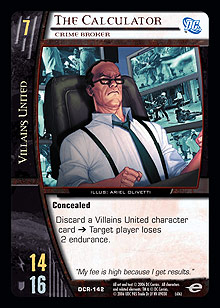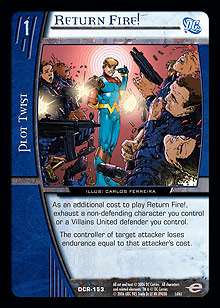
This week, I planned to stick to the straight and narrow, giving you a one- to four-star review of each of the Villains United cards in Infinite Crisis. As I sat and contemplated the comparative value of each card, I realized that I wasn’t having any fun, which led me to think that you wouldn’t have much fun reading what I had to say, either.
As a writer and teacher of Vs. System, I am horrified of becoming boring, especially so early in my writing career. I still plan to share my assessed values of the Villains United cards, but first, let’s talk about an Infinite Crisis Sealed Pack archetype that I plan to try out at the next opportunity. If you will, please let me introduce you to a theory and an archetypal concept that share the same name:
The Calculator
 This Sealed Pack archetype revolves around one common card: . At my Infinite Crisis Sneak Preview, I witnessed instances of 8 to 10 free endurance loss being dealt by this card. That’s a lot of burn, folks! I thought to myself, “If I began the game at 50 endurance, while my opponent began at, say, 42, what would have to go right or wrong for me not to win on turn 7?” This led me to do a little calculating of my own.
This Sealed Pack archetype revolves around one common card: . At my Infinite Crisis Sneak Preview, I witnessed instances of 8 to 10 free endurance loss being dealt by this card. That’s a lot of burn, folks! I thought to myself, “If I began the game at 50 endurance, while my opponent began at, say, 42, what would have to go right or wrong for me not to win on turn 7?” This led me to do a little calculating of my own.
2 + 2 + 3 + 3 + 4 + 4 + 5 + 5 + 6 + 6 + 7 = 47
I had never given any thought to these numbers before now. What are they? Character costs. To be more specific, these numbers represent the endurance loss from exactly stunning an opponent’s curve of characters on every turn. I am making a few assumptions in my calculations:
Assumption 1: Both my opponent’s curve and mine begin with a 2-drop and run smoothly up the curve through turn 7.
Assumption 2: On each of my attacks, I will be able to stun all of my opponent’s characters.
Assumption 3: On each of my opponent’s attacks, my character will stun his or her attacker.
Assumption 4: My opponent and I will choose to recover the largest character in play each turn.
Assumption 5: No breakthrough is dealt on any of these attacks.
Sticking with these assumptions and taking no other variables into account, both players will lose 47 endurance from these attacks. Add to that the 8 or so points of burn that you will get from The Calculator, Crime Broker, and you have a game plan.
Assumption 6: I will recruit The Calculator, Crime Broker on turn 7 with three or more Villains in hand to discard to his power.
Of course these conditions will almost never be met exactly. Vs. System is a game of options. Many other variables come into play. Factors like combat-modifying cards, characters of different sizes, luck, and skill were completely ignored to arrive at this total of 47. I just wanted to have some idea of what it would take to win the game with The Calculator on turn 7. Or rather, I wanted to see if it looked like surviving until turn 7 would be possible, and then if victory on turn 7 would be achievable.
It looks to me like “the calculated victory” plan seems pretty doable. Let’s take a look at some of the ludicrous assumptions that were made and see if we can do anything to increase the chances of creating a similar scenario.
I prefer a smooth character curve from 2 to 7 in Sealed Pack. This preference is shared by many, so assumption 1 does not seem too farfetched. As for having The Calculator in my card pool, that’s a requirement for trying this archetype, so I will say that the deck construction portion of assumptions 1 and 6 will be as close to constant as I could hope.
Getting the choice of initiative can play a role in determining a match’s victor. Initiative is a variable that cannot be held constant, so for this example, initiative is ignored and assumptions such as “no breakthrough endurance loss will be dealt,” “both players’ characters will stun each turn,” and “each player will choose to recover his or her largest character” are made instead. I know a few of the assumptions made in this article are absurd. Mostly, these are made just to calculate the base endurance loss each player should incur from stuns alone.
Assumption 4 (recover the largest stunned character) is generally the norm. Typically, assumption 2 (I will stun all defenders) is the desired norm for most competitors.
Assumption 5 (no breakthrough) will probably never happen. Breakthrough endurance loss is a variable that I will have to try to control as best as possible. If I am dealing extra breakthrough while still stunning my opponent’s board on my initiative, there will be little need to worry. However, if I lose 16 endurance over the course of the first six turns to breakthrough (or to other variables that I cannot control) while still keeping my other assumptions in place, I will lose the game on turn 6.
2 + 2 + 3 + 3 + 4 + 4 + 5 + 5 + 6 + 16 breakthrough = 50
So, now I know what has to be done in order to survive until turn 7: I cannot lose 16 non-stun endurance before then.
The only one of my assumptions that I have not touched upon yet is number 3 (my defenders will stun back each attacker). Trying to bring this to life would require playing as many Nasty Surprise effects as possible. It looks to me like The Calculator, Evil Oracle is one of the only characters or plot twists that Villains United offers in terms of modifying a defender’s ATK value.
The Villains United team has a lot of burn effects aside from the crime-brokering Calculator, though. If mutual stunbacks cannot be achieved each turn, then burn and breakthrough will have to substitute. A mechanic shared among many of the Villains United characters is that they return to your hand for some effect. This lends itself very well to the big turn 7 calculated finish.
 In Sealed Pack, two or more teams have to be played. It seems that the JSA offers up a few more cards to assist in the defender stunbacks. Superman, Earth 2 and Michael Holt ◊ Mr. Terrific, Renaissance Man are both powerful characters. It is probably no coincidence that the Villains United team has Return Fire!, which not only burns but also enables a few of the JSA’s characters that are strongest when exhausted.
In Sealed Pack, two or more teams have to be played. It seems that the JSA offers up a few more cards to assist in the defender stunbacks. Superman, Earth 2 and Michael Holt ◊ Mr. Terrific, Renaissance Man are both powerful characters. It is probably no coincidence that the Villains United team has Return Fire!, which not only burns but also enables a few of the JSA’s characters that are strongest when exhausted.
If you can team-up these two teams, try to get the odd initiatives, and lose less than 16 endurance in excess of stun damage, I’d say you have a recipe for success. Be sure to try to take advantage of the effects that require you to return a character to your hand. Having as many spare Villains in hand on turn 7 as possible will provide quite a powerful payoff.
A Quick Villains United Sealed Pack Value Guide
The cards below are sorted in order of my preference by cost within card type. I will not comment on each card, and I will keep the comments I do make brief. The key below will probably suffice for commentary on each of the cards.
* I do not want to play this card in Sealed Pack.
** This card is playable/average/filler.
*** This card is very good. I will usually play it in Sealed Pack.
**** This card is amazing. I will play it in Sealed Pack whenever possible.
Alexander Luthor, Duplicitous Doppelganger *
Cheetah, Feral Feline **
Count Vertigo, Werner Vertigo **
The Calculator, Noah Kuttler **** This is probably the only 1-drop Villain I would want in my Sealed Pack deck.
Ishmael Gregor ◊ Sabbac, Malevolent Marvel *
Dr. Psycho, Mental Giant *** He has a high ATK value and a relevant power.
Talia, Beloved Betrayer *** She has strong stats.
Weather Wizard, Mark Mardon *** This card’s vengeance power is not too shabby, and the character also flies.
Dr. Polaris, Force of Nature **
Dr. Light, Furious Flashpoint *** The character advantage should show immediate payoff.
The Calculator, Evil Oracle ***
Zazzala ◊ Queen Bee, Mistress of the Hive *** This goes up or down in value depending upon the number of return effects you have.
Bizarro, ME AM BIZARRO #1 ** Large stats are quickly offset by a big drawback.
Deathstroke the Terminator, Lethal Weapon **
Fatality, Flawless Victory ***
Sinestro, Villain Reborn ***
Alexander Luthor, Insidious Impostor **** Of course, a character this powerful should be a rare.
Cheshire, Jade **
Mr. Freeze, Brutal Blizzard **** One of many great options with a cost of 5.
Black Adam, Teth-Adam ****
Talia, Daughter of Madness ****
Dr. Psycho, Twisted Telepath * He has been awful every time I’ve seen him in play.
Alexander Luthor, Diabolical Double *** The large DEF should help get you to turn 7.
Hunter Zolomon ◊ Professor Zoom, Sinister Speedster ***
Deathstroke the Terminator, Ultimate Assassin ***
The Calculator, Crime Broker **** I love this card!
Black Adam, Lord of Kahndaq *** It has a powerful effect, but turn 8 is often one turn too late.
Join Us or Die * Until an opponent blows me out by triggering vengeance on one of his or her cards with Join Us or Die, I will not play it.
3 . . . 2 . . . 1 . . . **
Return Fire! **
Arms Deal ** This card is most likely designed for Constructed play. I might be terribly wrong, though. As it is a rare, I haven’t yet had the chance to play with it in Sealed Pack.
No Hope **
No Mercy ***
Baddest of the Bad **** Character search is always very valuable. This card searches for off-team characters also.
Coercion, Team-Up **** This is especially great when combined with the 1-drop Calculator.
Grand Gesture **** This is exactly what I would expect for a team-stamped combat pump for the Villains United team.
Systematic Torture **** KO and burn taste good together.
The Science Spire **** This is the type of search effect that tips the scales in your favor over a number of turns in Sealed Pack.
See you next week for further review of the Infinite Crisis set. I’ll post a follow-up to my Calculator Sealed Pack deck as soon as I get the time and the card pool to play it.